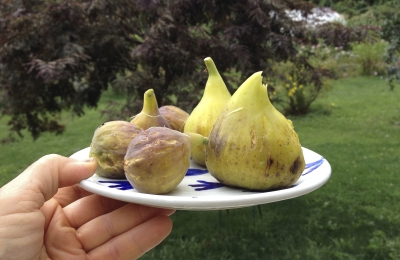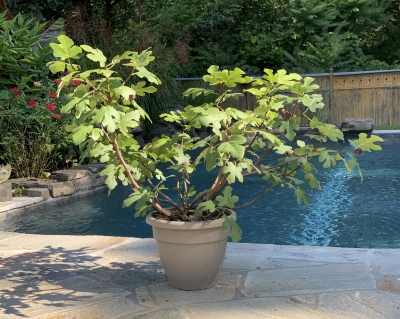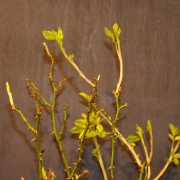AN ANCIENT FRUIT, STILL POPULAR
You’ve caught me at a good time. I’m just now dipping my toes into figdom, and in the next few days expect to be swimming in a sea of fresh, ripe figs.

You’ve never tasted a fresh, ripe fig? Don’t judge them by what you might buy in the market. Ripe figs are very perishable so for commercial purposes must be harvested slightly underripe. But figs don’t ripen at all after harvest, which is why market figs are but a shadow of the real thing.
Fresh, ripe figs are ubiquitous in California, Florida, and other mild winter regions, so perhaps are ho-hum to those living in those parts. Not here in New York’s Hudson Valley though, where winter temperatures dipping to minus 20 degrees Fahrenheit are no surprise!
Five Ways with Figs
I — and you —can grow figs in cold climates by one of five techniques I describe in my new book, hot off the press, Growing Figs in Cold Climates. The easiest way is to just plant the fig in a pot that can bask in sunlight outdoors in summer, and then be moved to a cold (ideally 30-45° F), but not frigid, location for winter. Figs are subtropical, not tropical plants, that actually enjoy this winter rest.

Fortunately, fig is a very adaptable plant. You can lop back its roots each winter, so you can pack new soil around its roots without having to move the plant to a bigger . . . and bigger . . . and bigger pot. You can prune stems more severely that most other fruit plants so it can be maneuvered through doorways for its winter rest. And no need for light in winter. And no pollination is necessary. And pest problems are rare.

Of course, there’s lots of wrinkles to getting a fig plant to fruit well in a pot: What’s the best potting mix? How do you prune for best yields? When do you move the plant to its winter quarter, to its summer quarters? How do you hold back growth waiting for equable spring weather?
Another method that I describe in my book is planting a fig tree outdoors (yes, here, where winters are frigid) and training it as an espalier. Espalier is the training of a plant’s stems, often a fruit plant, to an orderly, usually two dimensional pattern. With fruit plants generally, and figs specifically, the result is more than just good looks; you get to pick lots of very high-quality fruit.

I have trained my plant to the form of an upside down L, consisting of a foot-high, permanent trunk and one permanent, horizontal “arm.” (I’m starting another plant, this one trained to a low T, with horizontal arms running in opposite directions.) Each summer vigorous shoots grow from the topside of the arm and bear fruits. New figs are born along the ever elongating shoots, ripening over a long period beginning with the oldest ones, lower down, until shoot growth and fruit ripening is halted by cold weather and short days.
In late fall, I cut every shoot back to its origin on the horizontal arm. Then I insulate the plant beneath a blanket of autumn leaves topped with a tarp to shed water, then perhaps more leaves to hide the tarp from view. Come spring, the cycle of fruiting, pruning, and insulating begins again.
Devil’s Details
With any of the methods described in my book, the devil is in the details, matching, for instance a particular method of growing the plant to the pruning technique and a variety’s bearing habit.
Speaking of bearing habit, that’s another characteristic of figs that make them such adaptable plants, able to be grown for their fruit even far from their native hot, dry, mild winter home in southern Arabia. While a peach tree bears fruits on stems that grew the previous season, and an apple tree usually bears fruit on stems two, three, or more years old, a fig tree might bear fruit on new, growing shoots; on one-year-old stems; or on both, all depending on the variety. So there’s not necessarily a need to have stems survive winter in order to get a crop the following season.

Early figs on old part of stem, later figs developing on new shoot
A nice offshoot (sic) of this bearing habit, for fig lovers/growers everywhere, is that fig plants are very quick to come into bearing. I’ve had plants bear the season after I rooted them from cuttings!
And many fig varieties potentially bear two crops each year. First to ripen is the crop borne on one-year-old stems. Later, the so-called main crop is born on new, growing shoots; this is the crop that continues ripening as the shoot grows, until stopped by cold weather and short days.
Why We Lust for Figs
I am among the many people, all over the world, who have wanted to grow figs. Fig was the first fruit I planted many years ago when I began gardening. I was living in Madison, Wisconsin where winter temperatures regularly plummeted to minus 25 degrees Fahrenheit!
Why the lust for figs? Perhaps because fig originated in one of the cradles of civilization, and is one of the oldest of cultivated fruits. It is the most mentioned fruit in the Bible (remember when Adam and Eve “knew that they were naked; and they sewed fig leaves together, and made themselves aprons.” It’s also one of the two sacred fruits of Islam, and figures prominently in Greek mythology.

Flavor has to figure in: A fully ripe fig is soft and juicy, with a honey sweet, rich flavor. If you already grow figs, I’m hoping my book will help you grow better or more figs, or be able to manage them more easily. If you haven’t yet experienced the rewards of growing figs, you have a treat in store for you.




11,400 years old, I have two varieties.
Have you ever tried to grow Chicago Hardy Figs? & if so how do they taste?
I am growing it now. I’ve always suspected that it is Brown Turkey, renamed. I will report back.
Nope didn’t work for me either today. Whoops just got it!
Been waiting a long time for this!
I grow both Brown Turkey and Chicago hearty. The one I have labeled as Chicago Hardy was earlier and bigger and lighter in color.
Hi Lee. Mine is 5 years old and with now just a minimal shape pruning is bearing well fir two years on!
Agree, agree, agree. I grew up in very south Georgia just on the Florida state line and unbeknownst to me at the time was so lucky to have so many fruit trees on my modest home’s property. My favorite was a fig tree that we were told was a “sugar fig.” Now that I am many years older and maybe not that much wiser but definitely more informed because of my interest in gardening and horticulture, I have no idea what a “sugar fig” is scientifically. After moving to he NYC area and trying to buy “sugar figs” each summer, I know that those days of finding a “sugar fig” instead of going into my back yard and picking such sweet figs are gone forever despite what anyone does here in the Northeast. A great lesson is you don’t know what you have you don’t have it.
Sugar Fig is another name for the variety Celeste, a small and, of course, very sweet fig.
I have been reading about Chicago Hardy so that I can plant several outdoors and not bring inside in winter – zone 7A – but seems more like 7B – a couple of miles from Long Island Sound in Westchester. Can you comment about that variety? Size and taste of fruit? Would plant this fall. Better to buy smaller size ( for ex., ones sold by Burpee) and let acclimate while small or a 1 gallon size from another place, which I know is not much larger but a lot more expensive? Would I get any fruit next summer? I understand not many pests (insects or disease). Is that correct? What about animals? Is that a big issue? I usually have battles every year with squirrels and chipmunks that like my tomatoes and berries. Gave up on berries because they always found a way to get in and around and/or under cages. Don’t want to spend the time and money if it’s going to be hard to get the fruit.
That’s a lot of questions! You should get a book 🙂 But briefly, you can grow most figs outside, perhaps with a little protection, in Zone 7A or B. Yes, furry and feathered animals also like figs. Depending on plant size, it may fruit next year.
Thank you so much. I did do a lot of reading but I wanted verification by THE expert. Do you think I will have as much trouble with animals with the figs as with berries?
Probably not quite as much, but a lot depends on the exact circumstances, such as proximity to house and people, surrounding woods, etc.
Lee – The link you provide for your book does not show your new book at that link. It shows all your other books but not the new one you mention in this post.
fyi – gayle
The link should have been corrected by now. If not, let me know. Thanks for your feedback.
The link for your book takes me to your store but this book isn’t listed there.
Perhaps you need to refresh the page. It took me there. Please get back to me if it still doesn’t work. Thanks.
We are in NWPA—about halfway between Erie and Pittsburgh—and have several well established potted figs we move in and out, and enjoy the figs we get from them very much. 3 years ago, we planted a couple of Chicago Hardy variety in a Sunny, somewhat sheltered part of the yard, and we’ve been amazed that they’ve done well, and have made at least SOME figs the past 2 years! (Quite a few this year!) The first year we put our empty potato boxes around them, and filled them with straw and a little mulch to hold it down. They died back to the ground. Last year, we left them open, and just mulched well over the roots. They seemed to like that treatment better, and are ROCKING!
That all makes sense. You must be in zone 6.
Yessir, you are correct! (At least until the new growing zone revision!)
Hi, The link for your book takes me to your store but this book isn’t listed there.
Please try again. The link has been fixed. Let me know if it still doesn’t work. Originally, it didn’t work in Safari browser but that’s been fixed
What variety of fig is in the (jealousy inspiring) photo of you about to ingest it?
It’s actually an unidentified variety. It was rescued by a friend along with some hasidic jews in NYC, given to another friend with a farm in Westchester, and then to me, via cuttings. Along the way, it was named Rabbi Samuel.
Thank you, I was hoping so. I got a clone of Rabbi Samuel from you a few years ago but it still has not born fruit. Does this variety take longer to mature than others? Sara’s Celeste is bearing well!
No, the Rabbi did not take long to bear for me. It turns out that Sara’s Celeste, as I expected, is not really Celeste. I’ve since then gotten the real Celeste; it fits the published descriptions.
Vindication! Sara’s Celeste is still a very good fig though.
Yes! Ver good.
I live in NW Georgia in the US, and I’m growing Brown Turkey fig trees from cuttings off the big tree we had at our former residence. Those died back during last year’s deep freeze here but I waited and eventually they came back and are beautiful. I also have a GE Neri fig tree – purportedly the world’s largest fig – that I bought out of Louisiana a couple of years ago. It was still in the pot when we moved to this location 2 years ago and this is its second year in the ground. It also died back and was the first of my figs to rebound. Recently I added a Madeleine fig, a variety I was not familiar with. I’m looking forward to seeing what that one does. The GE Neri and one of the Brown Turkeys has put on figs but we are closing in our first frost, so it’s doubtful those ripen in time.
Be careful: Collecting fig varieties can become addictive! I’ve been there.I’m now whittling my collection to the best tasting (to me) for my site.
Lee: I just received your book and have only had time for a brief skim, but I know it will be my fig bible – excellent and filled with valuable info, illustrations, and photos.
I have 3 Ronde de Bordeaux figs but don’t have a very cool place to winter them – the coolest room I have available is about 55-60 F and last year they had new growth of 12-20″ when I took them out of the dark room (I cut it all off). Is it OK to prune and plant them outdoors this late in the fall, protect them, and start training them as espalier trees next spring? Of should I overwinter them in the warmish room and plant in the spring? Thank you for a great website, books, and blog.
Outside,the plants will not survive your winter without protection. If you plant it outside in spring and train it to a low espalier, it is easily protected beneath an insulated covering (leaves, etc) along with a tarp to shed water. You’ll probably need some sort of mouse control also.
Sorry – I forgot to note in my post about Ronde de Bordeaux figs that I live in central New Hampshire – Zone 5. Thanks